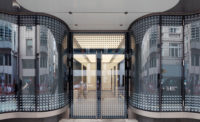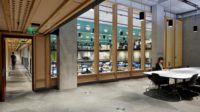Combining organizational clarity with a facade system that creates expressive patterns of shadow and light, the Burntwood School in southwest London has won over critics, as well as the students who use it. The Stirling Prize recipient in 2015, the multi-building campus serves 2,000 secondary-school girls (ages 11 to 18), who were engaged in workshops with the architects during the design process and now express pleasure with the results. Executed in phases, the project involved tearing down some existing buildings, retaining two, and erecting six new ones.
Additional Content:
Jump to credits & specifications
The original 1950s campus, designed by a highly regarded British modernist, Sir Leslie Martin (1908–2000), needed a lot of work—many of its buildings were outdated, with narrow corridors and precast-concrete cladding panels that, while generally well liked, provided poor sound and thermal insulation. The new project’s architect, Paul Monaghan of the large London-based firm Allford Hall Monaghan Morris (AHMM), says he was partly inspired by Martin’s buildings but wanted to develop a suite of precast insulated concrete cladding components that could be varied but also replicable, to achieve economies of scale.
One of the last projects in the British government’s Building Schools of the Future program, Burntwood’s expansion and rehabilitation began right after the financial crisis of 2008. At a time of economic austerity, it was lucky to get approved at a total project cost of $62 million. It also benefited from a committed head teacher, Helen Dorfman, and pupils of diverse backgrounds who lobbied the government’s education minister. Dorfman is a keen admirer of modern architecture. “I told my senior team to go to the David Chipperfield exhibition at the Design Museum,” she says.
She and Monaghan discussed such greats as Ludwig Mies van der Rohe and Marcel Breuer while the process unfolded, as well as the existing Martin buildings. Monaghan’s designs for the school’s four teaching blocks recall the old ones, with their precast-concrete panels, but are more visually striking and do a better job of blocking out sound and keeping in heat. Martin’s original school assembly hall was saved, though, along with his swimming pool and gym building, which had been reclad by others a decade ago.
The generous 12.6-acre site meant that, with careful phasing, there was room to build the new teaching buildings while the old ones were in use, decanting pupils across campus without the need for temporary classrooms. The program started with a new sports hall clad in black precast-concrete planks, alongside the existing swimming pool building. But the real aesthetic tour de force came with the teaching blocks and their system of deeply articulated concrete panels.
During a visit on a wet winter’s day, Monaghan fretted that there might not be enough daylight to see the sparkle of mica in the teaching buildings’ dark concrete ground-level panels; off-white panels on the upper floors have a corresponding dark aggregate fleck in them. No need to worry: these smooth precast units—distinctly Breuer-ish in feel—are impressive both from a distance and close up. Their 20-inch depth and faceted components give them a strong character. The concrete’s finish is matte but fine-textured, and all the pieces fit together tightly, so the facades aren’t blemished by the kind of wide mastic joints common in large-panel buildings from the 1950s and ’60s. And by contrasting dark and light concrete and inserting a narrow, vertically ribbed dark band at the base, Monaghan was able to make these buildings appear to float.
The facade panels, which are 12 feet high (floor to floor) come in two widths—10 and 15 feet—to provide variety across the 25-foot-wide classroom (and structural) module. The size and orientation of the window apertures vary according to use—in some cases, achieved by simply rotating the panels. Altogether, 11 molds were used to create nearly all the variations: a few purpose-made “specials” accommodated the rest.
The back-insulated panels—delivered to the site with factory-fitted glazing—were hung on stainless-steel fittings, on building frames of poured-in-place concrete. For sheltered terraces open to the air, the panels have unglazed apertures. Floor slabs were omitted in some areas to create double- or triple-height spaces, such as the tiled entrance portals to the teaching blocks and the informal study spaces found inside. The library in the arts and technology building is double-height, with a consequent double layer of windows. This variety of spaces enlivens what is otherwise a thoroughly conventional plan: rectangular, with a broad central corridor and standard-sized classrooms and lecture halls on either side, many equipped with movable internal walls.
The exception to this construction method is the steel-framed Performing Arts and Dining building. A huge self-service restaurant equipped with long refectory tables occupies the ground floor and spills out to an exterior space protected by the deeply cantilevered floor above. Upstairs, there are drama and dance studios, a lecture theater, and seminar rooms. Monaghan enclosed the building with a curtain wall system of glazed and solid-metal panels, both giving the same strong vertical emphasis found in the restored 1950s Assembly Hall, to which it links at the first-floor level via a concrete ramp.
The final element is the outdoors. “It was important to us that the buildings and the landscape worked to complement each other,” says Dorfman.
Asked how much of a say students had in the design, the student council replied in a statement, “Girls from each year group were randomly selected and gave ideas.” These students met with the architects, took part in workshops, and explained what they felt was important. Any quibbles with the result? Yes, they have a few minor complaints, such as the need for more privacy blinds in some places and better locks on the washrooms. But, overall, they seem delighted. How do they describe the architecture? “It’s the contrast of the greenery with the concrete,” says one student. “Like diamonds reflecting light,” says another. When the Stirling Prize victory was announced, the school’s students reportedly burst into applause.
PeopleArchitect: Allford Hall Monaghan Morris, Morelands
Personnel in architect's firm who should receive special credit: Paul Monaghan (registered architect), Ben Gibson (registered architect), Daniel Lewis (registered architect), Lukas Ochendal (registered architect), Ben Leach (registered architect), Alan Worn (registered architect), Simon Allford (registered architect), Jonathan Hall (registered architect), Peter Morris (registered architect)
Engineer: Buro Happold
Consultants: Landscape: Kinnear Landscape Architects Artist: Studio Myerscough MEP Engineer: Mott Macdonald Fulcrum Fire Consultant: Tenos Fire Engineering Lighting: Mott MacDonald Fulcrum Acoustical: Mott Macdonald Fulcrum Ecology Consultant: The Ecology Consultancy Access Consultant: David Bonnett Associates Planning consultant: Nathaniel Lichfield and Partners FF&E: Smart FFE ICT Consultant: Civica Ltd Catering Consultant: Design Catering Equipment Ltd
General contractor: Lend Lease
Photographers: Timothy Soar +44 (0)1842 878773 Rob Parrish +44(0)7834 987002
Client: Wandsworth Council and Burntwood School
Size: 230,000 square feet
Cost: $62.2 million
Completion date: October 2014
|
ProductsStructural system Insitu concrete floors: Skydeck system – Mitchellson building frame contractor Precast concrete stairs: London Precast Manufacturer
Exterior cladding Metal/glass curtain wall: AluK curtain walling system - Fleetwood Architectural Aluminum contractor Precast concrete external cladding: Techrete External canopy: Broxap System
Roofing Built-up roofing: Inverted roof system – Kingspan insulation and hot applied polymer Permatec Ecowrap
Windows Metal frame: AluK Window system double glazed polyester powder coated - Fleetwood Architectural Aluminum contractor
Glazing Skylights: Coxdome
Doors Entrances: AluK door system Folding screens: Alcowall system Wood internal doors: MJ Hilson Limited
Hardware Handles: Aspex UK Ironmongery
Interior finishes Metal balustrade: Annandale Design Manufacturer Acoustical ceilings: Armstrong Acoustic paneling: Ecophon Paints and stains: Dulux Paneling: Delta Laminates cubicle paneling system Plastic laminate: Formica Wall tile: Johnson Tiles (color print tiles) Carpet and matting: Heckmondwike Raised flooring: Kingspan raised access floor system Floor trims/ stair edging: Gradus
Furnishings Chairs: Sebel Postura (classroom), Origin POP (Chair breakouts) Tables and chairs, canteen cafe: Very Good & Proper Tables and chairs, canteen cafe: James Burleigh Bosa
Lighting Interior lighting: Whitecroft Lighting
Conveyance Elevators/escalators: Otis elevators
|



















Post a comment to this article
Report Abusive Comment